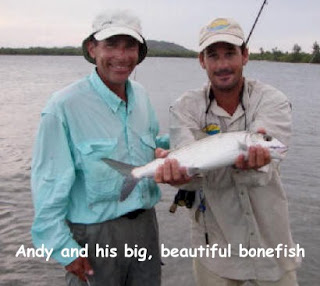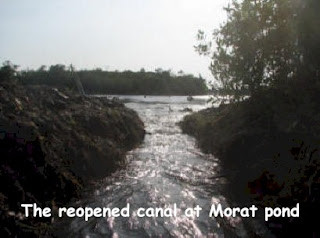First, a lighter-weight rod and line allow for a softer presentation of the fly. In instances in which a bonefisherman might normally opt for an 8-wt. set-up, gearing down even to a 7-wt. might make a difference (as long as the distance and accuracy of your casts don't suffer too much). Also, unweighted flies in the size 10-12 range make casting to a school of tailing bonefish even less conspicuous. So, with many days of calm water and spooky fish ahead of us this summer, thinking small might be one key to catching big fish. As one past guest put it, "It's saltwater spring creek fishing."
Here's a run-down of our recent guests:
Guests Andy Klein and Bob Pearson both hooked up to a number of nice-sized bones during their week stay at the lodge in early May. Andy had been to Roatan before on a diving vacation but had come this time to check out the flats with his old college roommate, Bob. The two of them had nice weather and plenty of shots at bones and permit. In the end, after 6 days of fishing and plenty of sightings, the permit wouldn't cooperate. However, their guide, Kessel, worked hard to get them onto some great bonefish.

These guys caught most of their fish on a small, brown bonefish bitter pattern--a Mango Creek staple. Our guides use this pattern often, both in brown and olive colors. They also found that a sturdy weed-guard was vital to keep the fly from catching the bottom of the shallower flats. As a quick solution, a short piece of monofilament can be tied and then glued to the head of the fly. This is possible with a variety of typical saltwater flies, making them more practical in shallow flats.
The week before, our guests included John and Margi Pearson, along with Margi's parents, Tom and Becky. After spending a few days on the flats near the lodge, they decided it would be worthwhile to make the trip over to Guanaja for a night. Leaving early Wednesday morning with our guides Tie-Tie and Kessel, the foursome spent 2 days wandering the sandy flats surrounding Guanaja and catching some huge bonefish. All four anglers had a wonderful time and said that the adventure to Guanaja really enriched their experience here. Undoubtedly, the chance to cast to bonefish this size in rarely fished water is a treat. But to be able to do it in such a gorgeous environment with the tall island of Guanaja in the background is what truly makes it special.


As far as other new fishing developments go at Mango Creek Lodge, everyone is excited about the unique possibilities offered by our Hobie kayaks. A few of our guides and management staff have had the chance to take these sleek crafts out for some exploratory runs. And after spending hours navigating the mangrove mazes on the far eastern end of the island, all agree that there is an enormous potential for some great fishing. Paddling the shallow mangrove ponds, well-hidden in the interior of the island, we spotted five or six large bonefish and a number of nice-sized snook. Our guides said that much of this water is unreachable in a skiff because the mangrove channels are too narrow and unwadeable because the bottom is far too soft. But in a kayak, we were able to get into these secluded areas quickly and quietly.
What has really been impressive is the stability and maneuverability of these kayaks. While moving along the slim canals, our guides were standing up in their boats and poling them along as they spotted fish. We've also found that the kayaks are more than stable enough to make a good, long cast with a fly rod without worrying about tipping over.
 Finally, our expeditions in the kayaks also led us to discovering another great fishing opportunity. On the island of Morat, which sits just beyond the eastern most tip of Roatan, there is a large tidal pond that is rumored to be a good snook fishery. In the past, it has been tough to make any decent cast to these fish. Just like the mangroves, there was no way to get a skiff into the pond, and the bottom was not nearly hard enough to wade. Yet again, we hoped that the kayaks would prove to be invaluable in reaching this area. But to our surprise, despite what many of the locals had told us, the pond was nearly dried up when we arrived. To make matters worse, the bodies of dead snook lie along the cracked edges of the water. Our Mango Creek guides told us that the pond had never been so low and were concerned that the remainder of the dry season would leave the pond completely emptied. Not wanting to lose such a promising spot, a crew was immediately sent up from the lodge to clear out the blocked connection with the ocean. Within 2 hours, the pond that had been almost completely empty was again filling with water. Hopefully, our efforts will be able to save the fish population of the Morat pond and provide us with another interesting place to explore.
Finally, our expeditions in the kayaks also led us to discovering another great fishing opportunity. On the island of Morat, which sits just beyond the eastern most tip of Roatan, there is a large tidal pond that is rumored to be a good snook fishery. In the past, it has been tough to make any decent cast to these fish. Just like the mangroves, there was no way to get a skiff into the pond, and the bottom was not nearly hard enough to wade. Yet again, we hoped that the kayaks would prove to be invaluable in reaching this area. But to our surprise, despite what many of the locals had told us, the pond was nearly dried up when we arrived. To make matters worse, the bodies of dead snook lie along the cracked edges of the water. Our Mango Creek guides told us that the pond had never been so low and were concerned that the remainder of the dry season would leave the pond completely emptied. Not wanting to lose such a promising spot, a crew was immediately sent up from the lodge to clear out the blocked connection with the ocean. Within 2 hours, the pond that had been almost completely empty was again filling with water. Hopefully, our efforts will be able to save the fish population of the Morat pond and provide us with another interesting place to explore.
